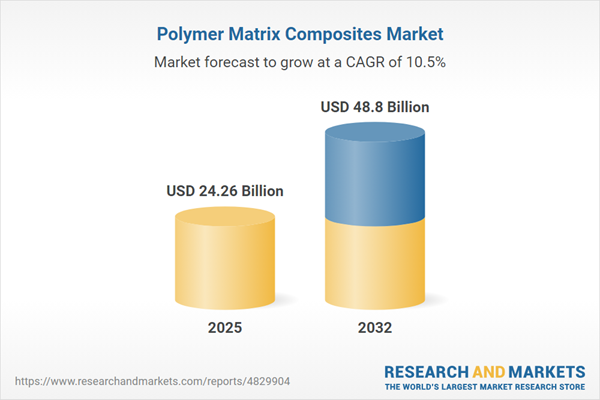Speak directly to the analyst to clarify any post sales queries you may have.
Polymer matrix composites are transforming material strategies across industries by enabling lighter, stronger, and more resilient products. Senior leaders must navigate the complex interplay of innovation, regulation, and supply chain shifts now driving this sector’s evolution.
Market Snapshot: Polymer Matrix Composites Market Trends and Growth
The polymer matrix composites market grew from USD 21.97 billion in 2024 to USD 24.26 billion in 2025, with an anticipated CAGR of 10.48% driving expansion to USD 48.80 billion by 2032. Demand stems from aerospace, automotive, construction, renewable energy, and other sectors striving for advanced materials to outperform traditional counterparts. Weight reduction, durability, and increasingly stringent environmental regulations are catalyzing rapid adoption, while R&D investment and technology integration fuel innovation across the value chain.
Scope & Segmentation: In-Depth Coverage Across the Polymer Matrix Composites Value Chain
- Matrix Material: Thermoplastic polymers and thermosetting polymers influence end-use performance, recyclability, and processing needs.
- Fiber Type: Aramid, carbon, glass, and natural fibers satisfy requirements for impact resistance, stiffness, affordability, or sustainability.
- End Use Industry: Applications span aerospace and defense, automotive, construction, marine, sports and leisure, and wind energy, each with sector-specific criteria for composites.
- Manufacturing Process: Techniques such as compression molding, filament winding, hand layup, injection molding, pultrusion, and resin transfer molding match varying volumes and geometry complexities.
- Geographic Coverage: The Americas, Europe, Middle East & Africa, and Asia-Pacific, with detailed insights for regions including North America, Latin America, Europe, the Middle East, Africa, China, India, Japan, Australia, South Korea, Southeast Asia, and key global markets.
- Leading Companies: Profiled firms include Toray Industries, Hexcel Corporation, Solvay S.A., SGL Carbon, Teijin Limited, Mitsubishi Chemical Holdings, Gurit Holding, Huntsman Corporation, Owens Corning, and 3M Company.
Key Takeaways for Senior Decision-Makers
- Advanced composites are enabling higher-productivity designs, longer asset life, and reduced energy consumption across multiple industries.
- Technological advancements such as nano-scale fillers, enhanced fiber treatments, and digital process controls create new performance possibilities while lowering material waste.
- Shifting regulatory requirements prioritize sustainability through lifecycle assessments, circular economy initiatives, and greater use of bio-based polymers.
- Rising input costs and margin pressures are compelling companies to optimize sourcing strategies and embrace nearshoring or regional production to manage volatility.
- Strategic partnerships and acquisitions drive competitiveness, enabling vertically integrated value chains and acceleration from pilot to commercial scale.
- Customizing fiber types, matrices, and manufacturing techniques allows organizations to fine-tune product performance to sector-specific needs and strict quality benchmarks.
Tariff Impact: Navigating Supply Chain Disruption and Cost Pressures
The imposition of new United States tariffs on polymer matrix composite precursors and finished goods beginning in 2025 is reshaping the supply landscape. Key players are reengineering sourcing, increasing domestic supply agreements, and investing in operational efficiencies to offset elevated costs. Regional manufacturing and nearshoring solutions are gaining favor, as stakeholders seek resilience against policy shifts and logistics bottlenecks. For OEMs, strategic vertical integration and local manufacturing partnerships are central to managing uncertainties and safeguarding delivery timelines.
Methodology & Data Sources: Robust Research for Reliable Insights
This report leverages primary interviews with R&D and manufacturing leaders, supported by a comprehensive review of patents, technical literature, and industry datasets. Triangulation ensures consistency and accuracy, with validation across vendor, regulatory, and expert sources.
Why This Report Matters: Strategic Value for Industry Leaders
- Benchmark technology adoption and supply chain strategies against sector peers for sustainable growth.
- Identify actionable opportunities in emerging application domains and new regional markets.
- Gain confidence in investment decisions with data-backed analysis and verified market intelligence.
Conclusion
Senior decision-makers relying on this report are equipped to strategically navigate advancing technologies, regulatory shifts, and evolving supply chains. Customized insights enable effective alignment of product and procurement strategies in a rapidly changing polymer matrix composites landscape.
Additional Product Information:
- Purchase of this report includes 1 year online access with quarterly updates.
- This report can be updated on request. Please contact our Customer Experience team using the Ask a Question widget on our website.
Table of Contents
3. Executive Summary
4. Market Overview
7. Cumulative Impact of Artificial Intelligence 2025
Companies Mentioned
The companies profiled in this Polymer Matrix Composites market report include:- Toray Industries, Inc.
- Hexcel Corporation
- Solvay S.A.
- SGL Carbon SE
- Teijin Limited
- Mitsubishi Chemical Holdings Corporation
- Gurit Holding AG
- Huntsman Corporation
- Owens Corning
- 3M Company
Table Information
| Report Attribute | Details |
|---|---|
| No. of Pages | 198 |
| Published | October 2025 |
| Forecast Period | 2025 - 2032 |
| Estimated Market Value ( USD | $ 24.26 Billion |
| Forecasted Market Value ( USD | $ 48.8 Billion |
| Compound Annual Growth Rate | 10.4% |
| Regions Covered | Global |
| No. of Companies Mentioned | 11 |









